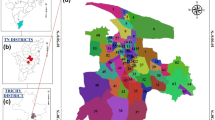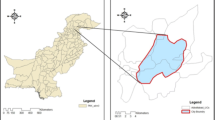Abstract
Education is a major force in economic, social and cultural empowerment. Primary education is compulsory, and the first stage in the education system of Ethiopia, and urges the provision of accessible service. However, presently, it is unclear that how well the services have been distributed and accessed in Bishoftu town, Ethiopia. For this primary schools in the town are considered and their spatial distribution and accessibility to the residents are explored using geographic information system as a tool for analysis. Location quotient and nearest neighbor analysis have been used to analyze spatial concentration and spatial distribution pattern of the schools, respectively. Computing service areas using road network distance and population density, the spatial accessibility of the schools has been compared and contrasted with standards in planning guide. As a result, inequality of service provision between neighboring areas in the town is found and the overall spatial distribution of the schools shows a clustered pattern. In addition, 23.9% of the residents are expected to travel more than twice of the maximum standard distance, indicates the current service provision is inadequate. The limitation is due to the combined effect of population distribution, spatial variables, socio-economic, and absence of regular monitoring and evaluation. The study would support the planning efforts being made to improve service provision, and it helps the government in formulating effective policies to the context.





Similar content being viewed by others
References
Gao, Y., He, Q., Liu, Y., Zhang, L., Wang, H., & Cai, E. (2016). Imbalance in spatial accessibility to primary and secondary schools in China: Guidance for education sustainability. Sustainability, 8, 1236. https://doi.org/10.3390/su8121236.
Chukwuemeka, O. (2013). Environmental influence on academic performance of secondary school students in Port Harcourt local government area of Rivers State. Journal of Economics and Sustainable Development, 4(12), 34–38.
Naidoo, A. G. V., Eeden, A. V., & Munch, Z. (2014). Spatial variation in school performance, a local analysis of socio-economic factors in Cape Town. South African Journal of Geomatics, 3(1), 78–94.
Wazzan, K. (2017). The spatial distribution of the basic education schools in Lattakia City (Syria). Journal of Educational and Social Research, 1, 1. https://doi.org/10.5901/jesr.2017.v7n1p71.
Woldehanna, T., & Araya, M. (2016). Educational inequalities among children and young people in Ethiopia. Country report. Young Lives, Oxford Department of International Development (ODID), University of Oxford.
Ministry of Finance and Economic Development (MoFED). (2010). Ethiopia: 2010 MDGs report, trends, and prospects for meeting MDGs by 2015. Addis Ababa, Ethiopia.
Federal Ministry of Education (FMoE). (2015). Education sector development programmed V (ESDP V). Ethiopia: Addis Ababa.
UNDP. (2015). Assessment of Ethiopia’s progress towards the MDGs. Millennium development goals report 2014 Ethiopia.
Ajala, O. A., & Asres, K. (2008). Accessibility inequality to basic education in Amhara Region, Ethiopia. The Ethiopian Journal of Education and Sciences, 3(2), 11–26.
Ministry of Education (MoE) and UNICEF. (2012). Study on situation of out of school children (OOSC) in Ethiopia.
Fabiyi, O. O., & Ogunyemi, S. A. (2015). Spatial distribution and accessibility to post primary educational Institution in Ogun State, Southwestern Nigeria: Case study of Yewa South Local Government Area, Nigeria. Journal of Scientific Research & Reports, 5(7), 542–552.
Bengston, D. N., Fletcher, J. O., & Nelson, K. C. (2004). Public policies for managing urban growth and protecting open space: Policy instruments and lessons learned in the United States. Landscape and Urban Planning, 69(2), 271–286.
Couch, C., & Karecha, J. (2006). Controlling urban sprawl: Some experiences from Liverpool. Cities, 23(5), 353–363.
Mekonnen M. (2012). Evaluation of land use planning and implementation with respect to environmental issues in Sululta town. M.Sc. Thesis in environmental planning and landscape design. Ethiopian Institute of Architecture, Building Construction and City Development/EiABC/, Addis Ababa University, Ethiopia.
Dukale Y. (2012). Assessment of urban plan and design implementation and management in Ethiopian secondary towns: The case of Dilla. M.Sc thesis in environmental planning and landscape design. Ethiopian Institute of Architecture, Building Construction and City Development/EiABC/Addis Ababa University, Ethiopia.
Bulti, D. T., & Sori, N. D. (2017). Evaluating land-use plan using conformance-based approach in Adama city. Ethiopia: Spatial Information Research. https://doi.org/10.1007/s41324-017-0125-3.
Ministry of Urban Development and Construction (MUDC) (2012). Urban planning, sanitation, and beautification bureau. Revised standards for structure plan preparation and implementation. Addis Ababa, Ethiopia.
Yi, L. (2004). Evaluation of accessibility to primary schools. M.Sc. Thesis. Urban planning and land administration. International Institute for Geo-Information Science and Earth observation, The Netherlands.
Ngigi, M. M., Musiega, D., & Mulefu, F. O. (2012). Planning and analysis of educational facilities using GIS: A case study of Busia County, Kenya. In Applied Geoinformatics for Society and Environment. Conference on GIS in Education July 2012 (pp. 261–269).
Olubadewo, O. O., Abdulkarim, I. A., & Ahmed, M. (2013). The use of GIS as educational decision support system (EDSS) for primary schools in fagge local government area of Kano State, Nigeria. Academic Research International, 4(6), 614–624.
Al-Rasheed, K., & El-Gamily, H. I. (2013). GIS as an efficient tool to manage educational services and infrastructure in Kuwait. Journal of Geographic Information System, 5, 75–86. https://doi.org/10.4236/jgis.2013.51008.
Mustapha, O. O., Akintunde, O. S., Alaga, A. T., Sharafdeen, O. B., Sunday, K., IsaIbrahim, et al. (2015). A geospatial approach to evaluation of accessibility to government primary schools in Ilorin West Local Government Area, Kwara State, Nigeria. European International Journal of Science and Technology, 4(8), 96–107.
Hameed, N. H. (2016). On the use of GIS technique to analyze the distribution of primary schools in Holy Karbala City. Engineering & Technology Journal, 34(15), 2816–2827.
Al-Enazi, M., Mesbah, S., & Anwar, A. (2016). Schools distribution planning using GIS in Jeddah City. International Journal of Computer Applications, 138(1), 33–36.
Aschale, T. M. (2017). Suitable areas by using GIS technology: In case of Debre Markos Town North Western Ethiopia. Journal of Resources Development and Management, 35(201), 8–20.
Begna, T. N. (2017). Public schools and private schools in Ethiopia: Partners in national development. International Journal of Humanities Social Sciences and Education (IJHSSE), 4(2), 100–111. https://doi.org/10.20431/2349-0381.0402010.
Oromia Urban Planning Institute (OUPI). (2009). Structural plan of Bishoftu Town, demographic profile, utilities, and social services final report, Addis Ababa, Ethiopia.
Central Statistical Authority (CSA). (2007). National population and housing census. Ethiopia: Addis Ababa.
Jahan, S., & Oda, T. (2005). Distribution of public facilities in Dhaka, Bangladesh: A spatial analysis. Dhaka Bangladesh: University of Engineering and Technology (BUET).
Han, Y. H., & Lu, Y. Q. (2012). Accessibility assessment and planning of public facilities for education: A case study on senior high schools in Yizheng City. Scientia Geographica Sinica, 32(7), 822–827.
Acknowledgements
We would like to thank the anonymous reviewers and the editor for their genuine comments and corrections which helps the paper to be in its present form.
Author information
Authors and Affiliations
Corresponding author
Rights and permissions
About this article
Cite this article
Bulti, D.T., Bedada, T.B. & Diriba, L.G. Analyzing spatial distribution and accessibility of primary schools in Bishoftu Town, Ethiopia. Spat. Inf. Res. 27, 227–236 (2019). https://doi.org/10.1007/s41324-018-0227-6
Received:
Revised:
Accepted:
Published:
Issue Date:
DOI: https://doi.org/10.1007/s41324-018-0227-6




